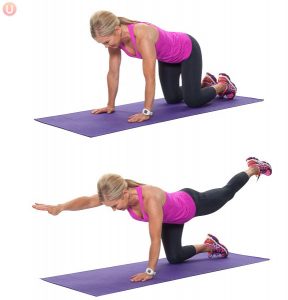
If you previously followed our Core Series you may be ready for some new exercises. If you have not seen it before, it is important to go back and start from Part 1 in order to get the basics of core activation. These exercises are more advanced and may not be suitable if you are suffering any injury such as back pain.
Remember that some of these exercises seem simple, but the challenge is in the execution. Be sure to focus on CONTROL, PRECISION and NOT GRIPPING with the superficial abdominal muscles which hold the spine stiff and increase compression through the spine. When using the core properly you should be able to stabilise the spine through movement.
These exercises will be challenging – but they should not be painful. If you need guidance to progress your program, get in touch.

1. Pointer: Kneel on hands and knees with hands under shoulders and knees under hips. Establish neutral spine so there is a slight curve in the lower back. Keep body still (no side shift, keep pelvis flat, do not increase arch in lower back), as you reach out one arm and opposite leg. This can be done next to a wall to ensure your body is not moving sideways over the kneeling leg. Repeat with the other arm/leg.

2. Knees side to side: Lie on your back with legs at table top as in the picture. (Hands wider will make the exercise easier, hands closer to the body make the exercise harder). Keep the shoulder blades flat on the ground as you inhale and both knees move to one side. Make sure knees stay together and dont split apart. Exhale to return, pulling back ribs, then hips and the legs just follow. Repeat in the other direction.

3. Single leg extension: Lie on back with your legs at table top. If you can place both hands under your lower back you should feel a small curve in your lower back. Feel the pressure on your hands and this should not change throughout this exercise. Exhale to extend one leg out- do not let the back arch and lift off your hand Inhale to return leg. Repeat with other leg. If you wish to make this harder, you can perform a sit up and maintain this throughout the leg extension. This allows you to look at your pelvis to ensure it isn’t moving side to side or backwards and forwards.

4. Dying bugs: Lie on your back with your legs at table top and your arms up towards the roof. Exhale and as one leg extends, opposite arm goes overhead. As in the previous exercise, the focus in on stabilising spine and pelvis. To progress this exercise, you can hold a FITT ball or a small weight in your hands and as one leg extends, both hands go overhead.

Lara is an Physiotherapist, Accredited Exercise Physiologist as well as a trained Pilates instructor. Lara works with our team at Caringbah. Lara’s enormous skill set means that she is ideally positioned to help manage all of your rehabiliation and injury management needs. To join Lara’s small group Clinical Pilates class or see her for a private consultation click to make a booking.